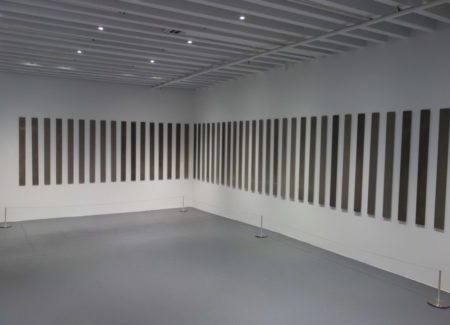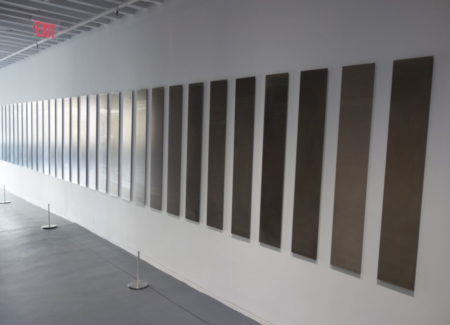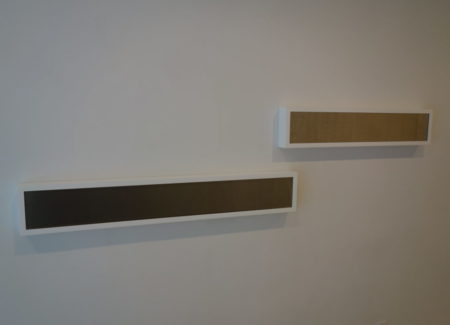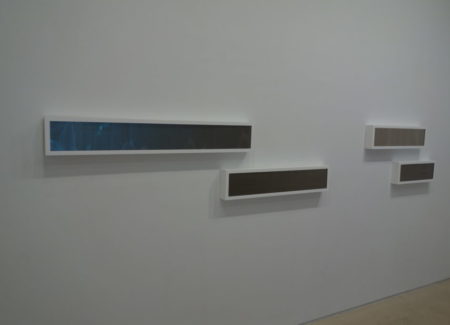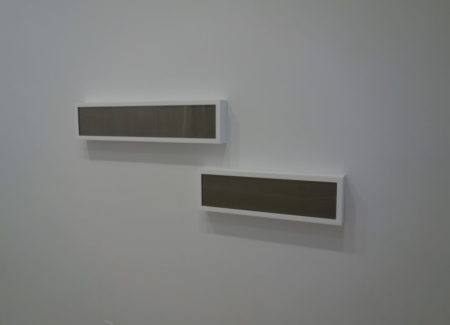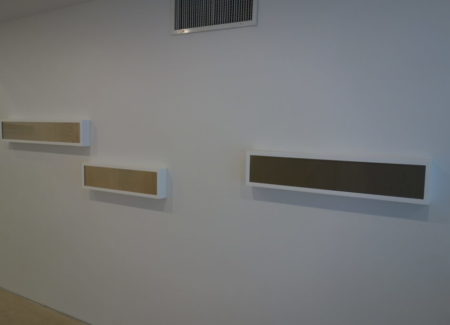JTF (just the facts): A two-venue exhibit of black and white works, hung against white walls in a series of rooms and the entry area at 88 Eldridge Street and in the main gallery space at 36 Orchard Street. The following works are on display in each location:
88 Eldridge Street
- 1 set of 60 silver gelatin photograms mounted on dibond, unframed, 2018, overall dimensions of 60×445 inches, unique
- 1 set of 45 silver gelatin photograms mounted on dibond, unframed, 2018, overall dimensions of 60×445 inches, unique
- 1 set of 30 silver gelatin photograms mounted on dibond, unframed, 2018, overall dimensions of 60×445 inches, unique
- 1 set of 15 silver gelatin photograms mounted on dibond, unframed, 2018, overall dimensions of 60×445 inches, unique (while this work is installed as one continuous group, it is being sold as 3 diptychs and 3 triptychs)
36 Orchard Street
- 7 pairs of silver gelatin photograms, framed in white, 2018, overall dimensions ranging from roughly 22×39 to 22×89 inches, unique
- 1 silver gelatin photogram, framed in white, 2018, roughly 8×35 inches, unique
(Installation shots below.)
Comments/Context: When we turn back to look at the earliest photographic studies of motion, the work of Eadweard Muybridge tends to get top billing. Muybridge famously used a complex camera setup to unravel the mystery of where the legs actually are during a horse’s gallop, and he went on to make a broad array of studies of men and women walking, playing, and doing everyday chores and of animals of all shapes and sizes moving through the world. His approach was built on the idea of time slicing, where individual exposures were made at discrete intervals and aggregated into sequential displays that unpacked the details of the specific progression.
Étienne-Jules Marey often plays second fiddle to Muybridge in the history books. And while they were both interested in providing a scientific basis for the flight of birds or the gait of humans, Marey took a decidedly different approach, gathering his multiple exposures into a single frame. This method allowed the elements of time and space to be measured more accurately – when the exposures are effectively piled on top of each other, it is much easier to see how far a wing or a foot traveled during the interval between exposures, or to measure how many intervals (and therefore how much time) was needed for a hammering arm to travel a certain distance to hit an anvil. Marey called this “chronophotography”, and over time, his innovations led to a “gun” that shot exposures at 12 frames per second, and proto-cinematic efforts that brought the image-making speed up to 60 frames per second.
In the past few years, Liz Deschenes has been looking back at these early days of photography as jumping off points for her own artistic inspiration, and this show reconsiders Marey’s insights within the context of Deschenes’ own experiments. The affinity between the two lies in the idea of a photograph measuring time and space rather than acting as a representation of some kind of pictorial reality. Deschenes has built her career on making sophisticated images that use process, resulting texture, and even nuances of display (like the play of light across a work) as their subject matter, so much of Marey’s original thinking actually falls into line with her own.
The show is spread across the gallery’s two exhibit spaces, with separate bodies of work filling each location. In the larger Eldridge Street space, Deschenes has installed four sets of photograms that interrogate our experience of passing time. Each work is a series of vertical strips arranged as a uniform sequence, with the individual strips hung 5 inches apart. The four works mimic the idea of “frames per second”, with the number and width of the strips changing to match either a 60, 45, 30, of 15 frames per second model. In FPS (60), there are 60 vertical strips, each 2.5 inches wide; in FPS (45), there are 45 vertical strips, each 5 inches wide; in FPS (30), there are 30 vertical strips each 10 inches wide, and in FPS (15), there are 15 vertical strips, each 25 inches wide. The effect of all this careful math is that the four works break the hanging (and in-between) space into different rhythms, the progression moving from staccato lines to thick blocks.
The photograms that make up these installations bear all the hallmarks of Deschenes’ aesthetics of subtlety. Each strip has tiny variations in tonality, along with small, almost invisible marks and gestures that might come from rollers, or washes of chemicals, or wispy amorphous patterns made by unknown techniques. On close inspection, often in raking light to actually see the surfaces, it appears that many of the strips were originally part of wider or larger compositions that were then cut into pieces and assembled into these installations; we can see the line of a roller move across one strip and keep going on an adjacent or nearby neighbor. In one work, the strips also intermittently alternate between glossy and matte surfaces.
So while any installation shots of these works inevitably make them look like flat uniform strips, the reality is much more varied and complicated, especially when the works are viewed at a slow walk. In this mode, the bars flicker by at seemingly different speeds, the 60 strips dashing by and the 15 strips reduced to a crawl. Variations in tonality seem to undulate through the pieces, like dark moving to light, or a surface pattern starts and stops, or repeats along a distance, creating the sense of expressive movement. Aside from one unfortunate window that interrupts the flow of one work, each one is a meditative stroll, the experience of the elapsed time seemingly modified by the changing of the underlying parameters. Seeing them in sequence makes these structural modifications more obvious, and it’s hard not to come away impressed by the intelligence that provides the foundation for these nuanced expressions.
In the Orchard Street space, Deschenes has taken a different approach, focusing more on the interconnection between time and physical space. In each pair of photograms, Deschenes imagines a human stride – one foot on the ground for a period of time, which is then lifted and replaced on the ground by the other foot, which stays there for a while. While the pairs travel from left to right on the wall, think of them as seen from above, and not as literal steps, but as representations of elapsed time (the length of the prints corresponding to the amount of time on the ground). Each gait is unique, with different motions (and rests) taking shape as the different lengths of the works, with the gaps capturing a moment when both feet were off the ground.
The photograms that make up these pairs seem to have even more tonal variety than the ones in the Eldridge Street galleries. Here, the slightly concave prints (curved just a bit, perhaps to catch the light better) wander through titanium and silver, gold and bronze, copper and olive, again with similar washes of chemicals, roller marks, and jittery seismograph-style lines decorating the surfaces. Since the scale of overall installation is more intimate, we are encouraged to get up close and examine the textures, where splotches, tiny dots, scrapes, and sweeps emerge from the subtleties of color. In these works, time becomes linear, and the photographs embrace that conception, marking and measuring an abstraction rather than documenting something representational.
While Deschenes’ work can at times feel aloof and inscrutable, the conceptual echo of Marey gives these two sets of images a fuller richness of purpose. Here her process-driven experiments are anchored to a framework that goes beyond exercises in surface, where the variables of time and space are incorporated via an aesthetic logic we can both decipher and follow. I found this sense of intentional activation to be smart and engaging, and the shifting effect between thinking and feeling has moments of sublime grace in these installations. With these two bodies of work as thoughtful examples, Deschenes is clearly making some of the best work of her career.
Collector’s POV: The works in this show are priced as follows. The large groups of prints at the larger location range from $325000 to $375000, with one set already sold. The group which is broken into diptychs and triptychs is priced at $80000 or $100000 based on the number of prints in the subset. The pairs of works at the other space range in price from $35000 to $55000, with the single work at $20000. Deschenes’ work continues to have very little secondary market history, so gallery retail remains the best/only option for those collectors interested in following up.

